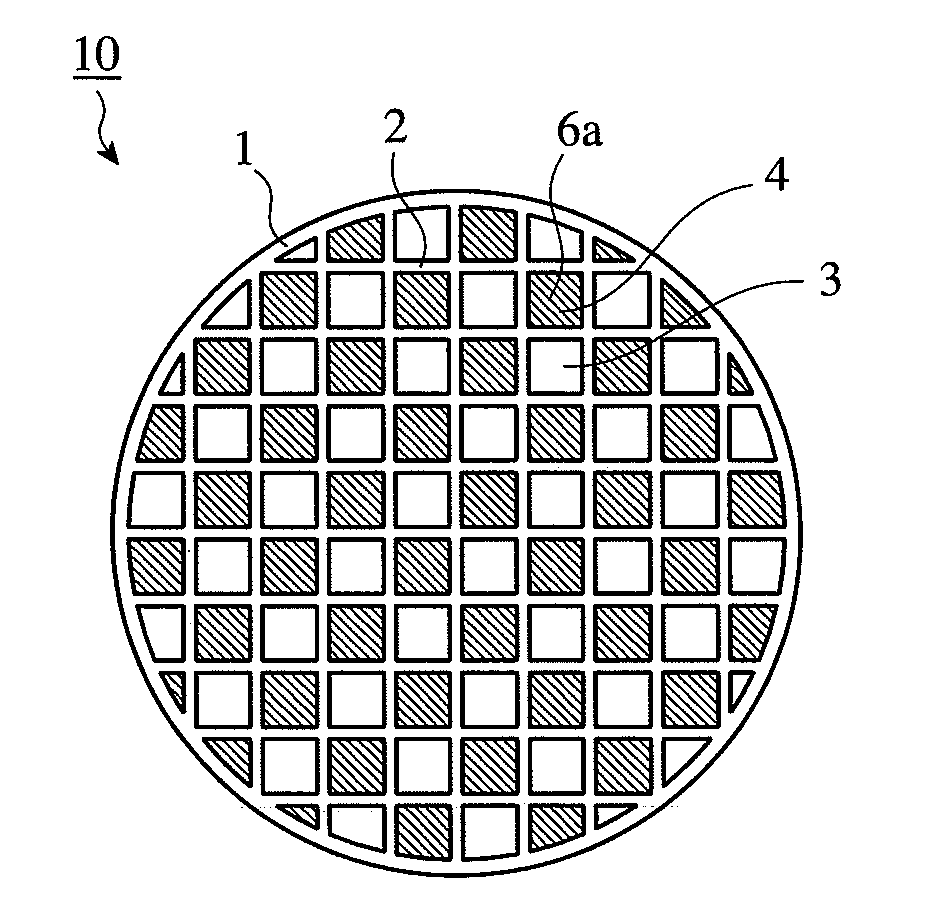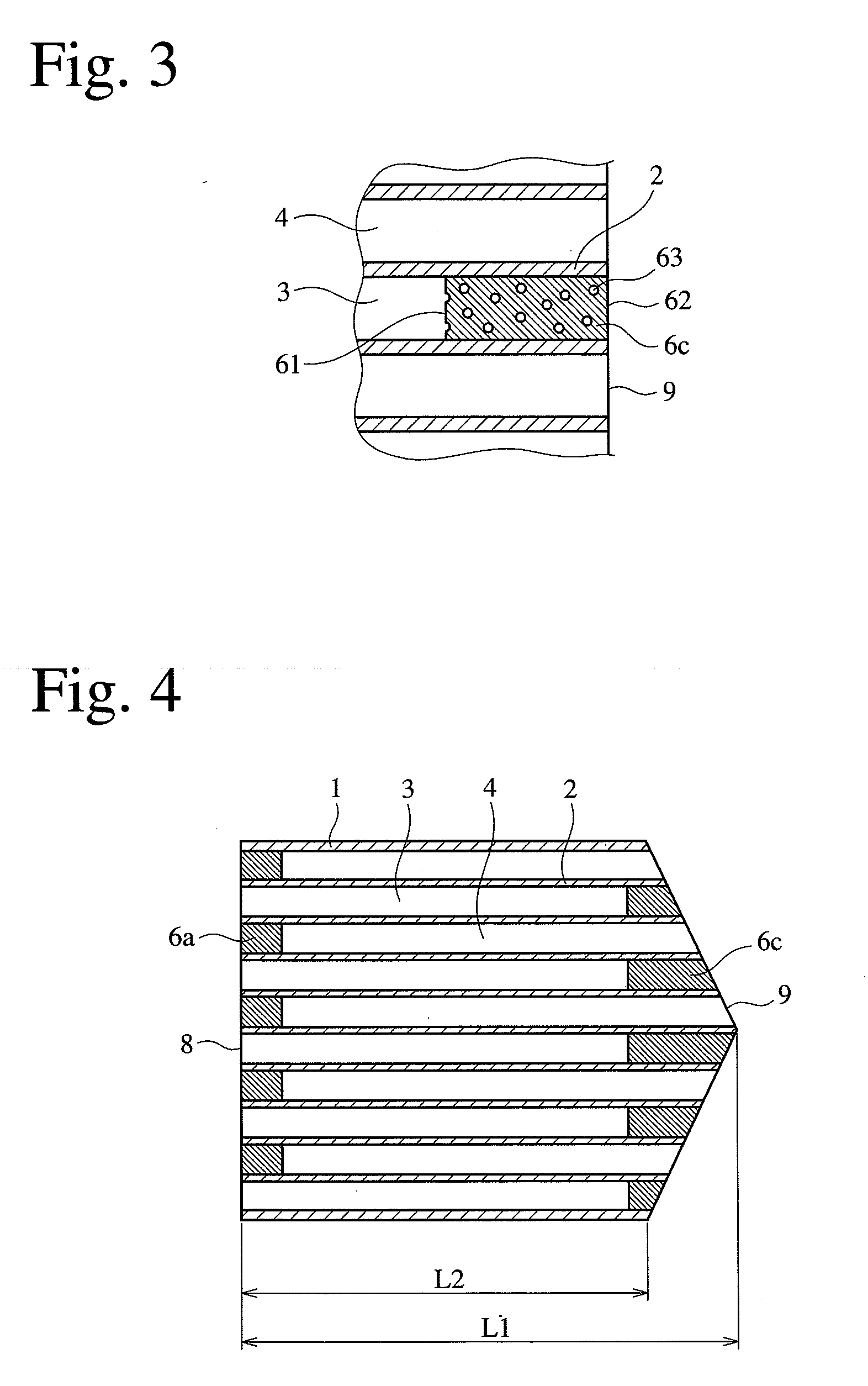Ceramic honeycomb filter and its production method
a honeycomb filter and ceramic technology, applied in the field of ceramic honeycomb filter, can solve the problems of increased pressure loss, adverse effects on human beings and the environment, melting erosion of the honeycomb filter, etc., and achieve the effect of reducing melting erosion and effective absorption of pm hea
- Summary
- Abstract
- Description
- Claims
- Application Information
AI Technical Summary
Benefits of technology
Problems solved by technology
Method used
Image
Examples
example 1
Production of Honeycomb Filter
[0033]To produce the honeycomb filter 10 shown in FIG. 2 by a known method, kaolin powder, talc powder, silica powder, alumina powder and aluminum hydroxide powder were mixed to prepare cordierite-forming material powder comprising 50% by mass of SiO2, 35% by mass of Al2O3 and 15% by mass of MgO. The amounts of these components may be adjusted in a range of 48-52% by mass for SiO2, 33-37% by mass for Al2O3 and 12-15% by mass for MgO. This powder was mixed with methylcellulose and hydroxypropyl methylcellulose as binders, a lubricant, and a foamed resin as pore formers. After thorough dry-blending, water was added to carry out sufficient kneading to prepare a moldable ceramic material. This moldable material was extrusion-molded and cut to produce a honeycomb-structure, molded article. This molded article was dried and sintered to produce a cordierite honeycomb structure. This ceramic honeycomb structure had an outer diameter of 150 mm, a length of 202 m...
examples 11-13
[0040]The honeycomb filters 10 of Examples 11 and 12 were produced in the same manner as in Examples 9 and 10, except that a plugging material slurry was supplied to the flow paths of each honeycomb structure, into which water was introduced in advance, and dried with the exhaust-gas-outlet-side end 9 upward, and that large-particle-size cordierite powder was sprayed onto each honeycomb structure placed with its exhaust-gas-inlet-side end 8 upward. The impregnation of the honeycomb structure with water was conducted by immersing portions corresponding to the outlet-side plugs 6c in water. The honeycomb filter 10 of Example 13 was produced in the same manner as in Example 12, except for changing the particle size of cordierite powder accumulated on the upstream-side end surfaces 61 of the outlet-side plugs 6c.
[0041]With respect to the honeycomb filters of Examples 11-13, the measurement of the length and porosity of the outlet-side plugs 6c and the surface roughness Ra of the upstre...
example 14
[0043]The same honeycomb filter as in Example 7 was produced to evaluate PM-burning efficiency by the following procedure.
Evaluation of PM-burning Efficiency
[0044]With air supplied at a flow rate of 5 Nm3 / min, pressure difference (pressure loss B) between the upstream side and the downstream side in the honeycomb filter was measured. 8 g / h of carbon powder having a particle size of 0.042 μm, which was generated by a fine particle generator, was introduced together with air at a flow rate of 15 Nm3 / min into the honeycomb filter through the exhaust-gas-inlet-side end 8 for 1 hour, so that the carbon powder was accumulated in the outlet-side-sealed flow paths 3 of the honeycomb filter. Further, air at 680° C. was supplied at 5 Nm3 / min to the honeycomb filter through the exhaust-gas-inlet-side end 8. While burning carbon powder, pressure difference (pressure loss A) between the upstream side and the downstream side in the honeycomb filter was measured, and the time period T until the ra...
PUM
| Property | Measurement | Unit |
|---|---|---|
| surface roughness Ra | aaaaa | aaaaa |
| porosity | aaaaa | aaaaa |
| porosity | aaaaa | aaaaa |
Abstract
Description
Claims
Application Information
 Login to View More
Login to View More - R&D
- Intellectual Property
- Life Sciences
- Materials
- Tech Scout
- Unparalleled Data Quality
- Higher Quality Content
- 60% Fewer Hallucinations
Browse by: Latest US Patents, China's latest patents, Technical Efficacy Thesaurus, Application Domain, Technology Topic, Popular Technical Reports.
© 2025 PatSnap. All rights reserved.Legal|Privacy policy|Modern Slavery Act Transparency Statement|Sitemap|About US| Contact US: help@patsnap.com



